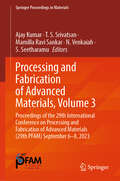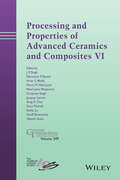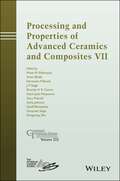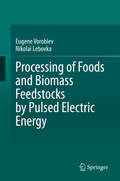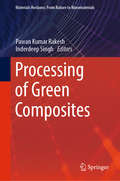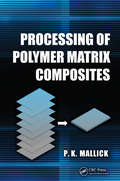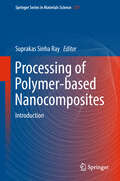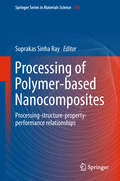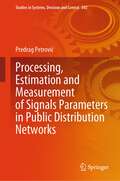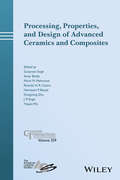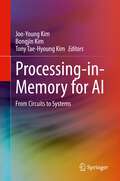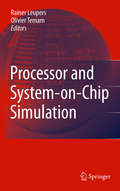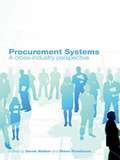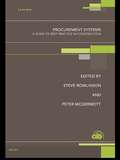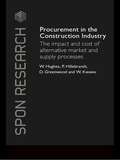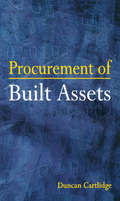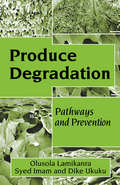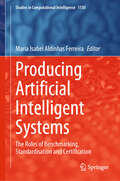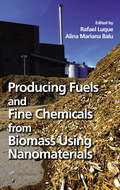- Table View
- List View
Processing and Fabrication of Advanced Materials, Volume 3: Proceedings of the 29th International Conference on Processing and Fabrication of Advanced Materials (29th PFAM) September 6–8, 2023 (Springer Proceedings in Materials #54)
by T. S. Srivatsan Ajay Kumar S. Seetharamu Mamilla Ravi Sankar N. VenkaiahThis book presents select proceedings of the International Conference on Processing and Fabrication of Advanced Materials (PFAM 2023). It covers the latest research in the areas of processing, fabrication, characterization and evaluation of traditional, advanced and emerging materials. The topics covered include various properties and performance attributes of modern-age materials. It further covers their applications in areas such as aerospace and other space-related industries, automobile, marine and defense, biomedical and healthcare, electronics and communications, energy storage/harvesting, heavy equipment, machinery and goods and semiconductor materials manufacturing. The book is a valuable reference for researchers and professionals interested in processing and fabrication of advanced materials and allied fields.
Processing and Nutrition of Fats and Oils (Institute of Food Technologists Series)
by Afaf Kamal-Eldin Ernesto M. HernandezProcessing and Nutrition of Fats and Oils reviews current and new practices of fats and oils production. The book examines the different aspects of fats and oils processing, how the nutritional properties are affected, and how fats interact with other components and nutrients in food products. Coverage includes current trends in the consumption of edible fats and oils; properties of fats, oils and bioactive lipids; techniques to process and modify edible oils; nutritional aspects of lipids; and regulatory aspects, labeling and certifications of fats and oils in foods.
Processing and Properties of Advanced Ceramics and Composites VI
by J. P. Singh Narottam P. Bansal Kathy Lu Jacques Lamon Takashi Goto Sung R. Choi Geoff Brennecka Gurpreet Singh Amar S. Bhalla Navin Jose Manjooran Gary Pickrell Morsi M. MahmoudWith contributed papers from the 2011 Materials Science and Technology symposia, this is a useful one-stop resource for understanding the most important issues in the processing and properties of advanced ceramics and composites. Logically organized and carefully selected, the articles cover the themes of the symposia: Innovative Processing and Synthesis of Ceramics, Glasses and Composites; Advances in Ceramic Matrix Composites; Solution-Based Processing of Materials; and Microwave Processing of Materials. A must for academics in mechanical and chemical engineering, materials and or ceramics, and chemistry.
Processing and Properties of Advanced Ceramics and Composites VII: Ceramic Transactions, Volume 252
by J. P. Singh Narottam P. Bansal Geoff Brennecka Gurpreet Singh Amar S. Bhalla Navin Jose Manjooran Gary Pickrell Morsi M. Mahmoud Dongming Zhu Ricardo Castro Sylvia JohnsonThis volume contains 40 papers from the following 10 Materials Science and Technology (MS&T'14) symposia: Rustum Roy Memorial Symposium: Processing and Performance of Materials Using Microwaves, Electric and Magnetic Fields, Ultrasound, Lasers, and Mechanical Work Advances in Dielectric Materials and Electronic Devices Innovative Processing and Synthesis of Ceramics, Glasses and Composites Advances in Ceramic Matrix Composites Sintering and Related Powder Processing Science and Technology Advanced Materials for Harsh Environments Thermal Protection Materials and Systems Advanced Solution Based Processing for Ceramic Materials Controlled Synthesis, Processing, and Applications of Structure and Functional Nanomaterials Surface Protection for Enhanced Materials Performance
Processing of Ceramics: Breakthroughs in Optical Materials
by Akio IkesuePROCESSING OF CERAMICS A firsthand account of the “transparent ceramics revolution” from one of the pioneers in the fieldProcessing of Ceramics: Breakthroughs in Optical Materials is an in-depth survey of the breakthrough research and development of transparent ceramics, covering historical background, theory, manufacturing processes, and applications. Written by an internationally-recognized leader in the technology, this authoritative volume describes advances in optical grade ceramics over the past three decades—from the author’s first demonstration of laser ceramics in Japan in 1991 to new applications of transparent ceramics such as ceramic jewels, wireless heating elements, and mobile device displays.The author provides numerous development examples of laser ceramics, crystal and ceramic scintillators, magneto-optic transparent ceramics, optical ceramic phosphors for solid state lighting, and more. Detailed chapters cover topics such as the technical problems of conventional translucent and transparent ceramics, the characteristics of scintillation materials, single crystal and ceramic scintillator fabrication and optimization, and solid-state crystal growth (SSCG) methods for single crystal ceramics.Processing of Ceramics:Outlines the author’s 30 years of work in the area of transparent ceramicsProvides a detailed history of the world's first ceramic laser developmentDemonstrates how laser oscillation using ceramic materials match or surpass high-quality single crystalsDescribes how innovative polycrystalline ceramics have transformed optical material developmentIncludes extensive references, chapter introductions and summaries, and numerous graphs, tables, diagrams, and color imagesProcessing of Ceramics is an invaluable resource for researchers, materials scientists, engineers, and other professionals across academic and industrial fields involved in the development and application of optical grade ceramics.
Processing of Foods and Biomass Feedstocks by Pulsed Electric Energy
by Eugene Vorobiev Nikolai LebovkaThis book presents a comprehensive range of research on pulsed electric energy used in food processing, including sections on the fundamentals of electroporation and important techniques for the estimation of electroporation effects in various foods and biomass feedstocks. By focusing on application over theory, this book presents researchers with practical steps for processing techniques such as solid-liquid extraction, pressing, osmotic dehydration, drying, freezing and cooking. Special interest is given to the selective recovery and extraction of sugar, inulin, starch, proteins, polysaccharides, polyphenols, pigments, flavor compounds, phytochemicals and other of high-value components from food biomasses such as fruits and vegetables, leaves, herbs, mushrooms, microalgae and suspensions of cells. Processing of Foods and Biomass Feedstocks by Pulsed Electric Energy presents a singular overview of the biorefinery applications of pulsed electric energy for the processing of wastes and non-food biomasses such as root and tuber crops, grape waste, lignocellulosic biomass, oil crops and residues and seeds and peels of exotic and citrus fruits. The book begins by presenting general information on the fundamentals of electroporation and information on the procedures and protocols involved. Further chapters focus on the specific food processing operations involved and biorefinery applications for the processing of wastes and non-food biomasses. All of the relevant and up-to-date information any researcher needs on pulsed electric energy in food processing is presented here in this text.
Processing of Green Composites (Materials Horizons: From Nature to Nanomaterials)
by Inderdeep Singh Pawan Kumar RakeshThis book is a collection of chapters focusing on green composite materials. The selection of natural fibers and polymer matrix materials, and the bonding between them forms an essential aspect of this book. The book discusses the chemical treatment of natural fibers and their compatibility with different matrix materials. The growing applications of composites in every day life ranging from automobiles to aerospace are also discussed. The book highlights the importance of processing of natural fiber reinforced composite materials to enhance their mechanical strength and performance. The contents of this book will be beneficial for students, researchers and industry professionals working on composite materials.
Processing of High-Temperature Superconductors at High Strain
by A.G. MamalisThe discovery of high-temperature superconductivity [1986] by Bendnorz and Muller in the La-BA-Cu-O system resulted in very extensive research work about the discovery and synthesis of other high-temperature superconductors, such as Y-BA-Cu-O and Bi-Sr-Ca-Cu-O. These new superconducting materials, possessing superconductivity above liquid nitrogen
Processing of Polymer Matrix Composites: Processing and Applications
by P. K. Mallick<p>Polymer matrix composites are finding increasing number of applications due to their high weight-saving potential as well as unique characteristics, such as high strength-to-density ratio, fatigue resistance, high damping factor, and freedom from corrosion. While many textbooks are available on the mechanics of polymer matrix composites, few cover their processing. Processing of Polymer Matrix Composites fills this gap. The book focuses on the major manufacturing processes used for polymer matrix composites and describes process details, process parameters and their effects on properties and process-induced defects, and analytical and experimental methods used for understanding process conditions. <p>The book describes fibers, thermosetting and thermoplastic polymers, and interface characteristics that are important from the standpoint of both design and processing. It also emphasizes the applications of process fundamentals for both continuous fiber and short fiber polymer matrix composites. In addition the book considers quality inspection methods, tooling, and manufacturing costs and environmental and safety issues.
Processing of Polymer-based Nanocomposites: Introduction (Springer Series in Materials Science #277)
by Suprakas Sinha RayProcessing of polymer nanocomposites usually requires special attention since the resultant structure—micro- and nano-level, is directly influenced by among other factors, polymer/nano-additive chemistry and the processing strategy. This book consolidates knowledge, from fundamental to product development, on polymer nanocomposites processing with special emphasis on the processing-structure-property-performance relationships in a wide range of polymer nanocomposites. Furthermore, this book focuses on emerging processing technologies such as electrospinning, which has very exciting applications ranging from medical to filtration. Additionally, the important role played by the nanoparticles in polymer blends structures has been illustrated in the current book, with special focus on fundamental aspects and properties of nanoparticles migration and interface crossing in immiscible polymer blend nanocomposites.This book introduces readers to nanomaterials and polymer nanocomposites processing. After defining nanoparticles and polymer nanocomposites and discussing environmental aspects, the second chapter focuses on the synthesis and functionalization of nanomaterials with applications in polymers. A brief overview on nanoclay and nanoclay-containing polymer nanocomposites is provided in third chapter. The fourth chapter provides an overview of the polymer nanocomposites structural elucidation techniques, such as X-ray diffraction and scattering, microscopy and spectroscopy, rheology. The fifth chapter is dedicated to the polymer nanocomposites processing technologies, among which electrospinning, which has very exciting applications ranging from medical to filtration. The last chapter provides an overview on how melt-processing strategy impact structure and mechanical properties of polymer nanocomposites by taking polypropylene-clay nanocomposite as a model system. The book is useful to undergraduate and postgraduate students (polymer engineering, materials science & engineering, chemical & process engineering), as well as research & development personnel, engineers, and material scientists.
Processing of Polymer-based Nanocomposites: Processing-structure-property-performance relationships (Springer Series in Materials Science #278)
by Suprakas Sinha RayProcessing of polymer nanocomposites usually requires special attention since the resultant structure—micro- and nano-level, is directly influenced by among other factors, polymer/nano-additive chemistry and the processing strategy. This book consolidates knowledge, from fundamental to product development, on polymer nanocomposites processing with special emphasis on the processing-structure-property-performance relationships in a wide range of polymer nanocomposites. Furthermore, this book focuses on emerging processing technologies such as electrospinning, which has very exciting applications ranging from medical to filtration. Additionally, the important role played by the nanoparticles in polymer blends structures has been illustrated in the current book, with special focus on fundamental aspects and properties of nanoparticles migration and interface crossing in immiscible polymer blend nanocomposites.This book focuses heavily on the processing technologies and strategies and extensively addresses the processing-structure-property-performance relationships in a wide range of polymer nanocomposites, such as commodity polymers (chapter 1), engineering polymers (chapter 2), elastomers (chapter 3), thermosets (chapter 4), biopolymers (chapter 5), polymer blends (chapter 6), and electrospun polymer (chapter 7). The important role played by nanoparticles in polymer blends structures in particular is illustrated.The book is useful to undergraduate and postgraduate students (polymer engineering, materials science & engineering, chemical & process engineering), as well as research & development personnel, engineers, and material scientists.
Processing of Synthetic Aperture Radar (SAR) Images
by Henri MaîtreSynthetic aperture radar provides broad-area imaging at high resolutions, which is used in applications such as environmental monitoring, earth-resource mapping, and military systems. This book presents the tools required for the digital processing of synthetic aperture radar images. They are of three types: (a) the elements of physics, (b) mathematical models and (c) image processing methods adapted to particular applications.
Processing, Estimation and Measurement of Signals Parameters in Public Distribution Networks (Studies in Systems, Decision and Control #502)
by Predrag PetrovićThe book addresses a relevant field of digital processing and measurement of signals in distribution networks. The importance of the covered topic is evidenced by extensive foreign and domestic professional literature, in the form of publications in leading international journals, and numerous professional and scientific books. For the past two decades, the author has published a number of papers both in international journals and at leading world conferences, further verifying the results he has achieved in this field. It should be noted that he is also the holder of several national patents, which were created precisely as a result of working on the problems of processing complex signals of voltage and current. Readers of this book will be the students of master and doctoral studies both in the country and abroad and experts in the field of signal processing. It is a valuable source for future authors of professional and scientific papers, as a basis on which to start when developing completely new techniques for processing complex signals not only in the power system, but also in other fields of engineering and everyday life.
Processing, Properties, and Design of Advanced Ceramics and Composites II
by J. P. Singh Narottam P. Bansal Susmita Bose Amit Bandyopadhyay Amar S. Bhalla Gary Pickrell Morsi M. Mahmoud Sylvia Johnson Ricardo H. Castro Michael Jenkins Hasan GöçmezProcessing, Properties, and Design of Advanced Ceramics and Composites II, Ceramic Transactions Volume 261 Narottam P. Bansal, Ricardo H. R. Castro, Michael Jenkins, Amit Bandyopadhyay, Susmita Bose, Amar Bhalla, J.P. Singh, Morsi M. Mahmoud, Gary Pickrell, and Sylvia Johnson; Editors This proceedings volume contains a collection of 36 papers (~350 pages) from the following symposia held during the 2016 Materials Science and Technology (MS&T’16) meeting held in Salt Lake City, UT, October 24-27, 2016: Advanced Materials for Harsh Environments Advances in Dielectric Materials and Electronic Devices Advances in Ceramic Matrix Composites Ceramic Optical Materials Controlled Synthesis, Processing, and Applications of Structural and Functional Nanomaterials Innovative Processing and Synthesis of Ceramics, Glasses and Composites International Standards for Properties and Performance of Advanced Ceramics Multifunctional Oxides Rustum Roy Memorial Symposium on Processing and Performance of Materials Using Microwaves, Electric, and Magnetic Fields Sintering and Related Powder Processing Science and Technology Surface Properties of Biomaterials Thermal Protection Materials and Systems Zirconia Based Materials for Cutting Edge Technology
Processing, Properties, and Design of Advanced Ceramics and Composites: Ceramic Transactions, Volume 259
by Narottam P. Bansal Gurpreet Singh Amar S. Bhalla Morsi M. Mahmoud Dongming Zhu Jitendra P. Singh Ricardo H. Castro Yiquan WuThis proceedings volume contains a collection of 34 papers from the following symposia held during the 2015 Materials Science and Technology (MS&T '15) meeting: Innovative Processing and Synthesis of Ceramics, Glasses and Composites Advances in Ceramic Matrix Composites Advanced Materials for Harsh Environments Advances in Dielectric Materials and Electronic Devices Controlled Synthesis, Processing, and Applications of Structure and Functional Nanomaterials Processing and Performance of Materials Using Microwaves, Electric and Magnetic Fields, Ultrasound, Lasers, and Mechanical Work, Rustum Roy Memorial Symposium Sintering and Related Powder Processing Science and Technologies Surface Protection for Enhanced Materials Performance: Science, Technology, and Application Thermal Protection Materials and Systems Ceramic Optical Materials Alumina at the Forefront of Technology
Processing-in-Memory for AI: From Circuits to Systems
by Joo-Young Kim Bongjin Kim Tony Tae-Hyoung KimThis book provides a comprehensive introduction to processing-in-memory (PIM) technology, from its architectures to circuits implementations on multiple memory types and describes how it can be a viable computer architecture in the era of AI and big data. The authors summarize the challenges of AI hardware systems, processing-in-memory (PIM) constraints and approaches to derive system-level requirements for a practical and feasible PIM solution. The presentation focuses on feasible PIM solutions that can be implemented and used in real systems, including architectures, circuits, and implementation cases for each major memory type (SRAM, DRAM, and ReRAM).
Processor and System-on-Chip Simulation
by Rainer Leupers Olivier TemamSimulation of computer architectures has made rapid progress recently. The primary application areas are hardware/software performance estimation and optimization as well as functional and timing verification. Recent, innovative technologies such as retargetable simulator generation, dynamic binary translation, or sampling simulation have enabled widespread use of processor and system-on-chip (SoC) simulation tools in the semiconductor and embedded system industries. Simultaneously, processor and SoC simulation is still a very active research area, e.g. what amounts to higher simulation speed, flexibility, and accuracy/speed trade-offs. This book presents and discusses the principle technologies and state-of-the-art in high-level hardware architecture simulation, both at the processor and the system-on-chip level.
Procurement Systems: A Cross-Industry Project Management Perspective
by Steve Rowlinson Derek WalkerInnovative and novel, this book extends its coverage of the topic well beyond the conventional themes of project solicitation and proposal evaluation. Using extensive experience gathered over five years of teaching postgraduate courses, Walker and Rowlinson build on Procurement Systems: A Guide to Best Practice in Construction to present a comprehensive and coherent volume that is invaluable to the wider project management community. Cross-disciplinary in approach, coverage includes general historical issues and practical discussions of different types of projects and their procurement needs. It provides and discusses cutting-edge research and thought leadership on issues such as: stakeholder management ethics and corporate governance issues business strategy implications on procurement e-business innovation and organizational learning cultural dimensions human resource development. Helping readers to design project procurement implementation paths that deliver sustainable value, this indispensable volume is key reading for students, lecturers and professionals working in or studying project management.
Procurement Systems: A Guide to Best Practice in Construction
by Peter McDermott Steve RowlinsonProcurement Systems details the whole spectrum of procurement issues in the construction industry, starting with the client /customer and running through managerial, cultural and IT-based issues. The book commences with an overveiw of previous work and a section on selection criteria is provided to enable practitioners to make their choices of procurement form. Importantly, perfromance comparisons of different procurement forms are discussed and the main emphasis of the book is to highlight best practice based on the most up-to-date research. One chapter deals specifically with developmentally orientated procurement issues in NICs (newly industrialised countries), where best practice is assessed from a different set of perspectives. The authors contributing to this book are among the most highly respected and eminent in the field.
Procurement in the Construction Industry: The Impact and Cost of Alternative Market and Supply Processes (Spon Research)
by William Hughes David Greenwood Patricia M. Hillebrandt Wisdom KwawuDo recent moves in the construction industry towards collaborative working and other new procurement procedures really make good business sense? Procurement in the Construction Industry is the result of research into this question and it includes the first rigorous categorizing of the differences between procurement methods currently in use. In the process of carrying out this research, the team has produced a comprehensive study of procurement methods which looks in detail at the relative benefits and costs of different ways of working, with sometimes surprising results. As such, it is not only a valuable guide for practitioners on the complexities of the procurement process, but also an outline of the relevance of economic theory to the construction sector.
Procurement of Built Assets
by Duncan CartlidgeThe ability to successfully procure built assets is at the heart of the construction process and in turn at the heart of the procurement process is identifying the constantly evolving needs of the construction client. Despite client criticism and a mountain of reports and statistics, spanning both the public and private sectors, until now the construction industry has failed to transform the diverse and often separate and inefficient processes of design and procurement of built assets into one single integrated production process. There are now signs however that the construction industry is beginning to transform its approach to built asset procurement and client care.This book draws heavily on the experiences and best practice of other industries and market sectors who have, just as construction is now having to do, taken a critical look at their procurement practices and techniques and the inherent waste in many traditional systems. The text includes practice-based case studies, from both the public and private sectors, to demonstrate how new procurement approaches are delivering value for money over the life cycle of built assets.This book is recommended reading for a range of students in the field of the built environment from quantity surveyors and commercial managers to architects and an essential and comprehensive guide to all construction procurement professionals seeking to familiarise themselves with the latest approaches to procurement.
Produce Degradation: Pathways and Prevention
by Olusola Lamikanra Syed Imam Dike UkukuProduce Degradation is the first book to focus on the processes that result in produce quality deterioration and their prevention. It addresses the mechanism of reactions that affect produce quality under conditions from the farm to the table. It also reviews the degradative changes and conditions that favor these processes, such as the biochemistr
Produced Water
by Jerry Neff Kenneth LeeA state-of-the-art review of scientific knowledge on the environmental risk of ocean discharge of produced water and advances in mitigation technologies. In offshore oil and gas operations, produced water (the water produced with oil or gas from a well) accounts for the largest waste stream (in terms of volume discharged). Its discharge is continuous during oil and gas production and typically increases in volume over the lifetime of an offshore production platform. Produced water discharge as waste into the ocean has become an environmental concern because of its potential contaminant content. Environmental risk assessments of ocean discharge of produced water have yielded different results. For example, several laboratory and field studies have shown that significant acute toxic effects cannot be detected beyond the "point of discharge" due to rapid dilution in the receiving waters. However, there is some preliminary evidence of chronic sub-lethal impacts in biota associated with the discharge of produced water from oil and gas fields within the North Sea. As the composition and concentration of potential produced water contaminants may vary from one geologic formation to another, this conference also highlights the results of recent studies in Atlantic Canada.
Producing Artificial Intelligent Systems: The Roles of Benchmarking, Standardisation and Certification (Studies in Computational Intelligence #1150)
by Maria Isabel Aldinhas FerreiraThe fast development of intelligent technologies in the previous years, their boost during the COVID crisis, and their huge acceleration with the proliferation of the Large Language Models has led industry, governance, legislators and regulators to race to achieve production control, striving to define regional and global regulatory frameworks, capable of guaranteeing their safe deployment.In an evolving and uneven regulatory context, balancing fast technological development and the safe and ethical use of these new disruptive technologies, with an expected total economic impact of 4.4 trillion dollars annually, becomes presently the biggest challenge. The present book addresses the fundamental role played by the three milestones- Benchmarking, Standardization, and Certification that are part of the developmental loop of all products in developed economies. The essential role played by these milestones and the importance of defining accurate general and specific metrics is addressed in this book with particular case studies in the domains of Robotics and AI-
Producing Fuels and Fine Chemicals from Biomass Using Nanomaterials
by Rafael Luque Alina Mariana BaluScarcity of resources and increasing population and energy demands are important issues of the twenty-first century. A multidisciplinary approach is needed to produce suitable alternatives-such as renewable resources-for a more sustainable future. One of the most promising and widely available renewable feedstocks is biomass, which has significant
